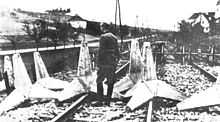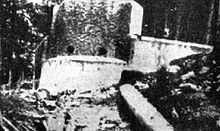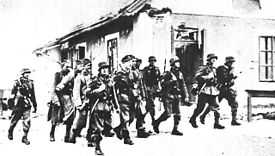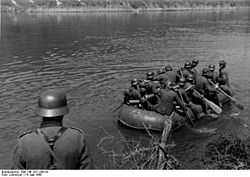7th Army (Kingdom of Yugoslavia)
| 7th Army | |
|---|---|
 Yugoslav obstacles placed across railway tracks near Spielfeld on the Yugoslav-Reich border | |
| Active | 1941 |
| Country |
|
| Branch | Royal Yugoslav Army |
| Type | Infantry |
| Size | Corps[lower-alpha 1] |
| Part of | 1st Army Group |
| Engagements | Invasion of Yugoslavia |
| Disbanded | 1941 |
| Commanders | |
| Notable commanders | Dušan Trifunović |
The 7th Army was a Royal Yugoslav Army formation commanded by Divizijski General Dušan Trifunović during the German-led Axis invasion of the Kingdom of Yugoslavia in April 1941 during World War II. It consisted of two divisions, two brigade-strength mountain detachments, and a brigade-strength infantry detachment. It formed part of the 1st Army Group, and was responsible for the defence of the northwestern border with Italy and the Third Reich.
On 6 April, the Germans seized several mountain passes and bridges over the Drava river. Slovene politicians formed a National Council of Slovenia with the intent of separating from Yugoslavia, and on the right flank of the 7th Army, the 4th Army was seriously weakened by Croat fifth column activities within its major units and higher headquarters from the outset. This alarmed Trifunović, but he was not permitted to withdraw from the border areas until the night of 7/8 April, and this was followed by the German capture of Maribor as they continued to expand their bridgeheads. Italian offensive operations then began, with thrusts towards Ljubljana and down the Adriatic coast, capturing over 30,000 Yugoslav troops near Delnice. On 10 April, the German 14th Panzer Division captured Zagreb, and on 12 April it linked up with the Italians near the Adriatic coast, encircling the remnants of the 7th Army. When fifth column elements arrested the staffs of 1st Army Group, 4th Army and 7th Army at Petrinja those formations effectively ceased to exist. The Yugoslav Supreme Command surrendered unconditionally effective on 18 April.
Formation

Yugoslav war plans foresaw the headquarters of the 7th Army and its army-level supporting units being created at the time of mobilisation. Unlike the other six Yugoslav armies, the 7th Army did not have a corresponding army district during peacetime, and would be allocated divisions when it was formed.[1] Zagreb, Karlovac, Trebnje and Velike Lašče were key centres for the mobilisation and concentration of the 7th Army due to their good rail infrastructure.[2]
Prior to the invasion, significant fortifications were constructed along the Italian and Reich borders, within what became the 7th Army area of operations. Along the frontier with Italy, mutually supporting bunkers were established on forward slopes of the mountain ranges behind a belt of obstacles. The main positions followed a line from Mount Blegoš south-south-east through Hlavče Njive, Žirovski Vrh, Vrh Svetih Treh Kraljev, Zaplana, Mount Slivnica, Grahovo, Lož to Petičak. To the north of Mount Blegoš, positions ran behind the lines of the Selška Sora and Sava Bohinjka rivers. Fortifications were also established in the mountainous Gorski kotar region between Karlovac and Rijeka on the upper Adriatic coast. Along the Reich border, the Yugoslavs concentrated on preparing to block the passes through the Karawank and Kamničk Alps, and built bunkers behind obstacles along the routes leading south from the border towards Dravograd, Maribor and Ptuj. Preparations were also made to block routes north of the Drava and along the southern banks of the Mura and Drava.[3]
Composition
The 7th Army was commanded by Divizijski General[lower-alpha 2] Dušan Trifunović, and his chief of staff was Pukovnik[lower-alpha 3] Vladimir Petrović. The 7th Army consisted of:[5]
- 32nd Infantry Division Triglavski
- 38th Infantry Division Dravska
- Mountain Detachment Triglavski (brigade-strength)
- Mountain Detachment Rišnajaski (brigade-strength)
- Detachment Lika (brigade-strength)
It was supported by the 71st Army Artillery Regiment, the 7th Anti-Aircraft Battalion, and the motorised 7th Army Anti-Aircraft Company.[5] The 6th Air Reconnaissance Group comprising sixteen Breguet 19s was attached from the Royal Yugoslav Air Force and was based at Cerklje near Brežice.[6]
Deployment plan
_location_map.svg.png)
The 7th Army was part of the 1st Army Group, which was responsible for the defence of northwestern Yugoslavia, with the 7th Army along the Italian and Reich borders, and the 4th Army defending the western sector along the Hungarian border.[7] The 1st Cavalry Division was to be held as the 1st Army Group reserve around Zagreb.[8] On the left of the 7th Army was the Adriatic coast at Karlobag,[9] and the boundary with the 4th Army on the right flank ran from Radgon on the Mura through Krapina and Karlovac to Otočac. The Yugoslav defence plan saw the 7th Army deployed in a cordon along the border region from the Adriatic in the west to Radgon in the east.[8][9] Of the formations of the 7th Army, the mobilisation of the three detachments was largely complete, but the two divisions had only commenced mobilisation.[10] All 7th Army formations were to be deployed in a cordon, although each formation was to create a second line of defence from its own troops.[7] The headquarters of the 7th Army was to initially be located in Brežice. The planned deployment of the 7th Army from west to east was:[9]
- Detachment Lika on the upper Adriatic coast from Karlobag through Otočac to Ogulin
- Mountain Detachment Rišnajaski around Delnice in the mountainous Gorski kotar region
- 32nd Infantry Division Triglavski southwest of Ljubljana in the Julian Alps
- Mountain Detachment Triglavski northwest of Ljubljana around Kranj
- 38th Infantry Division Dravska in the Pohorje mountains around Maribor
Army-level and rear area troops were to be deployed in the area of Brežice, Zidani Most and Novo Mesto.[9] Border guard units were to man fortifications along the Italian and Reich frontiers in the 7th Army area of responsibility, and consisted of:[11]
- the 554th and 555th Independent Battalions, in the sector of Detachment Lika
- the 1st Border Regiment and an independent border battalion, supported by one border artillery battalion fielding three batteries, in the sector of Mountain Detachment Rišnajaski
- the 2nd and 3rd Border Regiments supported by two border artillery battalions fielding eight batteries, in the sector of the 32nd Infantry Division Triglavski
- the 4th and 5th Border Regiments supported by one border artillery battalion fielding three batteries, in the sector of Mountain Detachment Triglavski
- the 6th, 7th and 8th Border Regiments supported by three border artillery battalions fielding a total of eight batteries, in the sector of the 38th Infantry Division Dravska
Mobilisation
A general mobilisation was not called until 3 April 1941, out of fear of offending Adolf Hitler.[12]
Detachment Lika
Detachment Lika was an adhoc formation consisting of the 44th Infantry Regiment and the 1st Battalion of the 17th Artillery Regiment. On 6 April, it was concentrating in the Otočac region, but the poor response to the mobilisation orders for the 44th Infantry Regiment meant that it was only at 35–40 percent of its strength.[13]
Operations
The border between the Reich and Yugoslavia was unsuitable for motorised operations.[14] Due to the short notice of the invasion, the elements of the invading German 2nd Army that would make up LI Infantry Corps and XLIX Mountain Corps had to be assembled from France, Germany and the Nazi puppet Slovak Republic, and nearly all encountered difficulties in reaching their assembly areas.[15] In the interim, the Germans formed a special force under the code name Feuerzauber (Magic Fire). This force was initially intended to merely reinforce the 538th Frontier Guard Division, who were manning the border. On the evening of 5 April, one of the aggressive Feuerzauber detachment commanders, Hauptmann Palten led his Kampfgruppe Palten across the Mura from Spielfeld and, having secured the bridge, began attacking bunkers and other Yugoslav positions on the high ground, and sent patrols deep into the Yugoslav border fortification system. Due to a lack of Yugoslav counter-attacks, many of these positions remained in German hands into 6 April.[14]

LI Infantry Corps were tasked with attacking towards Maribor then driving towards Zagreb, while the XLIX Mountain Corps was to capture Dravograd then force a crossing on the Sava.[7] On the first day of the invasion, LI Infantry Corps captured the Drava bridges at Mureck and Radkersburg (opposite Radgon) undamaged, and the 183rd Infantry Division captured 300 prisoners. A bicycle-mounted detachment of the 183rd Infantry Division reached Murska Sobota without striking any resistance. The 132nd Infantry Division also pushed south along the Sejanski valley towards Savci.[16]
Late that day, mountain pioneers destroyed some isolated Yugoslav bunkers in the area penetrated by Kampfgruppe Palten.[14] On that day, the governor of the Drava Banovina, Marko Natlačen met with representatives of the major Slovene political parties, and created the National Council of Slovenia, whose aim was to establish a Slovenia independent of Yugoslavia. When he heard the news of fifth column-led revolts within the 4th Army, Trifunović was alarmed, and proposed withdrawal from the border areas, but this was rejected by the commander of the 1st Army Group, Armijski đeneral[lower-alpha 4] Milorad Petrović. The front along the border with Italy was relatively quiet, with only patrol clashes occurring. The Yugoslav High Command ordered that the 7th Army capture Fiume, across the Rječina river from Sušak, but the order was soon rescinded.[17]

Over the next three days, LI Corps held the lead elements of its two divisions back while the rest of each division detrained in Graz and made their way to the border.[16] All elements of both divisions had unloaded by 9 April.[18] On the afternoon of 7 April, German Junkers Ju 87 Stuka dive bombers of Sturzkampfgeschwader 77 escorted by Messerschmitt Bf 109E fighters caught the Breguet 19s of the 6th Air Reconnaissance Group on the ground at Cerklje, destroying most of them.[6] As a result of the revolts in the 4th Army, on the night of 7/8 April, Petrović ordered the 7th Army to begin to withdraw, first to a line through the Dravinja river, Zidani Most bridge and the right bank of the Krka river. This was subsequently moved back to the line of the Kupa river.[17] On 8 April, disregarding orders from above, Palten led his Kampfgruppe south towards Maribor, and crossed the Pesnica river in pneumatic boats, leaving his unit vehicles behind. In the evening, Palten and his force entered Maribor unopposed, taking 100 prisoners. Kampfgruppe Palten was ordered to return to Spielfeld, and spent the rest of the invasion guarding the border. In the meantime, the forward elements of the two divisions consolidated their bridgeheads, with the 132nd Infantry Division securing Maribor, and the 183rd Infantry Division pushing past Murska Sobota.[16]
The activities of Natlačen and his council continued from the day the invasion commenced, and the Yugoslav High Command soon ordered their arrest. However, the chief of staff of the headquarters of the 1st Army Group, Armiski General Leon Rupnik and the head of the operations staff, Pukovnik Franjo Nikolić did not carry out the orders.[17] On 9 April, the 6th Air Reconnaissance Group airfield at Cerklje was again attacked by German aircraft.[19]
During the night of 9/10 April, lead elements of the XLIX Mountain Corps, consisting of the 1st Mountain Division de-trained and crossed the border near Bleiburg and advanced southeast towards Celje, reaching a point about 19 kilometres (12 mi) from the town by evening.[20] Luftwaffe reconnaissance sorties revealed that the main body of the 7th Army was withdrawing towards Zagreb, leaving behind light forces to maintain contact with the German bridgeheads. When it received this information, 2nd Army headquarters ordered LI Corps to form motorised columns to pursue the 7th Army south, but extreme weather conditions and flooding of the Drava at Maribor on 10 April slowed the German pursuit.[16]
On 10 April, as the situation was becoming increasingly desperate throughout the country, Dušan Simović, who was both the Prime Minister and Yugoslav Chief of the General Staff, broadcast the following message:[21]
All troops must engage the enemy wherever encountered and with every means at their disposal. Don't wait for direct orders from above, but act on your own and be guided by your judgement, initiative, and conscience.— Dušan Simović
Fate

About 06:00 on 11 April, LI Corps renewed its push south towards Zagreb, with lead elements exiting the mountains northwest of the city in the evening of the same day,[20] while the 1st Mountain Division captured Celje after some hard marching and difficult fighting. Emissaries from the newly formed National Council of Slovenia approached the commander of XLIX Mountain Corps, General der Infanterie Ludwig Kübler to ask for a ceasefire.[20] Also on 11 April, the Italian 2nd Army commenced offensive operations around 12:00,[22] with the XI Corps pushing through Logatec towards Ljubljana, VI Corps advancing in the direction of Prezid, while strong formations attacked south through Fiume towards Kraljevica and towards Lokve. By this stage, the 7th Army was withdrawing, although some units took advantage of existing fortifications to resist.[23]
To assist the Italian advance, the Luftwaffe attacked Yugoslav troops in the Ljubljana region, and the 14th Panzer Division, which had captured Zagreb on 10 April, drove west to encircle the withdrawing 7th Army. The Italians faced little resistance, and captured about 30,000 Yugoslav troops waiting to surrender near Delnice. On 12 April, the 14th Panzer Division linked up with the Italians at Vrbovsko, closing the ring around the remnants of the 7th Army,[22] which promptly surrendered.[24] The Croatian fascist organisation, the Ustaše, arrested the staffs of the 1st Army Group, and 4th and 7th Armies at Petrinja, and the 7th Army effectively ceased to exist as a formation.[23] After a delay in locating appropriate signatories for the surrender document, the Yugoslav High Command unconditionally surrendered in Belgrade effective at 12:00 on 18 April.[25]
Notes
- ↑ The Royal Yugoslav Army did not field corps, but their armies consisted of several divisions, and were therefore corps-sized.
- ↑ Equivalent to a United States major general.[4]
- ↑ Equivalent to a United States colonel.[4]
- ↑ Equivalent to a United States lieutenant general.[4]
Footnotes
- ↑ Terzić 1982, p. 104.
- ↑ Terzić 1982, p. 181.
- ↑ Terzić 1982, p. 148.
- ↑ 4.0 4.1 4.2 Niehorster 2013a.
- ↑ 5.0 5.1 Niehorster 2013b.
- ↑ 6.0 6.1 Shores, Cull & Malizia 1987, p. 201.
- ↑ 7.0 7.1 7.2 Krzak 2006, p. 584.
- ↑ 8.0 8.1 Geografski institut JNA 1952, p. 1.
- ↑ 9.0 9.1 9.2 9.3 Terzić 1982, p. 164.
- ↑ Barefield 1993, p. 52.
- ↑ Terzić 1982, pp. 259–260.
- ↑ Tomasevich 1975, p. 64.
- ↑ Terzić 1982, p. 260.
- ↑ 14.0 14.1 14.2 U.S. Army 1986, p. 55.
- ↑ U.S. Army 1986, pp. 47–48.
- ↑ 16.0 16.1 16.2 16.3 U.S. Army 1986, p. 57.
- ↑ 17.0 17.1 17.2 Krzak 2006, p. 585.
- ↑ U.S. Army 1986, p. 48.
- ↑ Shores, Cull & Malizia 1987, p. 216.
- ↑ 20.0 20.1 20.2 U.S. Army 1986, p. 58.
- ↑ U.S. Army 1986, p. 53.
- ↑ 22.0 22.1 U.S. Army 1986, p. 60.
- ↑ 23.0 23.1 Krzak 2006, p. 595.
- ↑ Zajac 1993, p. 35.
- ↑ U.S. Army 1986, pp. 63–64.
References
Books
- Geografski institut JNA (1952). "Napad na Jugoslaviju 6 Aprila 1941 godine" [The Attack on Yugoslavia of 6 April 1941]. Istorijski atlas oslobodilačkog rata naroda Jugoslavije [Historical Atlas of the Yugoslav Peoples Liberation War]. Belgrade, Yugoslavia: Vojnoistorijskog instituta JNA [Military History Institute of the JNA].
- Shores, Christopher F.; Cull, Brian; Malizia, Nicola (1987). Air War for Yugoslavia, Greece, and Crete, 1940–41. London: Grub Street. ISBN 978-0-948817-07-6.
- Terzić, Velimir (1982). Slom Kraljevine Jugoslavije 1941 : uzroci i posledice poraza [The Collapse of the Kingdom of Yugoslavia in 1941: Causes and Consequences of Defeat] (in Serbo-Croatian) 2. Belgrade, Yugoslavia: Narodna knjiga. OCLC 10276738.
- Tomasevich, Jozo (1975). War and Revolution in Yugoslavia, 1941–1945: The Chetniks. Stanford, California: Stanford University Press. ISBN 978-0-8047-0857-9.
- U.S. Army (1986) [1953]. The German Campaigns in the Balkans (Spring 1941). Washington, D.C.: United States Army Center of Military History. OCLC 16940402. CMH Pub 104-4.
Journals and papers
- Barefield, Michael R. (May 1993). "Overwhelming Force, Indecisive Victory: The German Invasion of Yugoslavia, 1941". Fort Leavenworth, Kansas: School of Advanced Military Studies, United States Army Command and General Staff College. OCLC 32251055.
- Krzak, Andrzej (2006). "Operation 'Marita': The Attack Against Yugoslavia in 1941". The Journal of Slavic Military Studies 19 (3): 543–600. doi:10.1080/13518040600868123. ISSN 1351-8046.
- Zajac, Daniel L. (May 1993). "The German Invasion of Yugoslavia: Insights For Crisis Action Planning And Operational Art in A Combined Environment" (PDF). Fort Leavenworth, Kansas: School of Advanced Military Studies, United States Army Command and General Staff College. OCLC 32251097.
Web
- Niehorster, Dr. Leo (2013a). "Royal Yugoslav Armed Forces Ranks". Dr. Leo Niehorster. Retrieved 24 May 2014.
- Niehorster, Dr. Leo (2013b). "Balkan Operations Order of Battle Royal Yugoslavian Army 7th Army 6th April 1941". Dr. Leo Niehorster. Retrieved 24 May 2014.
| ||||||||||||||